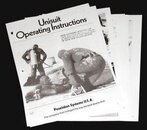AfterDark
Contributor
I understand that the general consensus is that she was a good diver. I also understand that she was having a lot of trouble with her dry suit.
In the mid 70's I was a young teenager and would absolutely freeze when diving 40 degree water in NJ. So I saved all my dishwashing money and bought a unisuit (neoprene dry suit). I was VERY careful with it. I read the entire manual (5-6 pages) a few times, the guy in the shop who sold it, told me to not let the boots fill with air and off I went to a quarry to test it out. I probably was solo, but I don't know.
I was thin and needed 40 lbs of lead. This was before power inflators were common and I had a horse collar BC, but this could not be used with the suit, so I had no BC. I thought it incredibly easy to just press a button and have air added, much easier than blowing up a BC orally. I was nervous with 40 lbs of lead hanging on a belt, but I found it easy to dive with. No lessons, no troubles, no issues other than the amount of lead precluded me from shore diving in big seas. Soon I was diving it solo in the ocean.
So, I am at a loss to understand how an extremely experienced diver would have continuing trouble with a dry suit. Maybe it is management of air in the BC AND the suit that is hard- something I didn't have to contend with? I never used a dry suit with a BC. Why does it take days to figure out?
As for the accident, people have been somewhat ambiguous about how deep it was when they descended, how far from shore it was (in feet) etc. I for one, would think nothing of a diver descending with 750 psi to the bottom in 12 feet and attempting to swim in 150 yards.
I tried to read the thread, but important basic facts are missing.
depth and distance from shore? (rather than shallow and close)
What type of weight system was she using?
Did she have a BP/W and a crotch strap over a weightbelt that would complicate ditching lead (as compared to a typical recreational BC)?
Why would an extremely experienced diver (repeatedly over the course of a few day) use a BC that would not have enough lift to hold them at the surface-this seems harder to explain than a failure to ditch lead in an emergency.
That is the same 1st dry suit experience I had except I was diving MA / RI. Dry suit diving just isn't that complicated especially for an experienced and accomplished diver. I don't have the unsuit anymore but I still have the manual.





